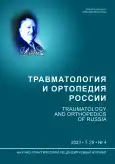Предложения по введению некоторых новых терминов в хирургию таза и вертлужной впадины
- Авторы: Заднепровский Н.Н.1, Куликов В.В.2, Владимирова Я.Б.2, Иванов П.А.1
-
Учреждения:
- ГБУЗ «Научно-исследовательский институт скорой помощи им. Н.В. Склифосовского Департамента здравоохранения г. Москвы»
- ФГАО ВО «Российский национальный исследовательский медицинский университет им. Н.И. Пирогова Минздрава России»
- Выпуск: Том 29, № 4 (2023)
- Страницы: 87-100
- Раздел: Дискуссии
- URL: https://journal-vniispk.ru/2311-2905/article/view/255336
- DOI: https://doi.org/10.17816/2311-2905-15531
- ID: 255336
Цитировать
Аннотация
Актуальность. Стремительное развитие современных хирургических методов лечения переломов костей таза выявило необходимость разработки нового терминологического аппарата, так как классическая анатомическая терминология таза перестала соответствовать запросам лечебного процесса и научных исследований в данной области. Классический набор анатомических названий и ориентиров не позволяет детально описывать все нюансы повреждений при применении современных хирургических методик. Имеющееся отставание системы терминов от уровня современной тазовой хирургии должно быть устранено для возможности подробно и понятно для всех специалистов характеризовать имеющуюся патологию и проводимое лечение.
Цель исследования — разработать названия для некоторых частей костей таза и его областей, которые до настоящего времени не имеют своих обозначений, и предложить разработанные термины для профессионального обсуждения.
Материал и методы. Выполнен ретроспективный анализ рентгенограмм и компьютерных томограмм пациентов с повреждением костей таза, выполненных с 2020 по 2022 г. В результате анализа литературы был составлен список потенциальных новых анатомических терминов.
Результаты. В ряде случаев мы столкнулись с дефицитом терминов при диагностике повреждений таза и описании хода операций. Разработаны новые термины для обозначения областей таза и их повреждений: основание лобковой кости, вертикальные переломы основания лобковой кости, продольные переломы основания лобковой кости, неполный разрыв лобкового симфиза, основание подвздошной кости, продольный перелом основания подвздошной кости, переломоподвывих и переломовывих основания подвздошной кости, калькар подвздошной кости, калькарный шип, костный коридор.
Заключение. Внедрение новых анатомических терминов в клиническую практику поможет улучшить точность диагностики и планирования хирургических вмешательств в тазовой области. Стандартизация терминологии будет содействовать единообразию подходов и обмену опытом между специалистами, что послужит повышению качества хирургического лечения пациентов с повреждениями таза.
Полный текст
Открыть статью на сайте журналаОб авторах
Никита Николаевич Заднепровский
ГБУЗ «Научно-исследовательский институт скорой помощи им. Н.В. Склифосовского Департамента здравоохранения г. Москвы»
Автор, ответственный за переписку.
Email: zacuta2011@gmail.com
ORCID iD: 0000-0002-4432-9022
канд. мед. наук
Россия, МоскваВладислав Владимирович Куликов
ФГАО ВО «Российский национальный исследовательский медицинский университет им. Н.И. Пирогова Минздрава России»
Email: vvk@rsmu.ru
ORCID iD: 0009-0007-2904-7135
д-р мед. наук, профессор
Россия, МоскваЯна Борисовна Владимирова
ФГАО ВО «Российский национальный исследовательский медицинский университет им. Н.И. Пирогова Минздрава России»
Email: yv.anatomy@gmail.com
ORCID iD: 0009-0003-0308-6081
канд. мед. наук
Россия, МоскваПавел Анатольевич Иванов
ГБУЗ «Научно-исследовательский институт скорой помощи им. Н.В. Склифосовского Департамента здравоохранения г. Москвы»
Email: ipamailbox@gmail.com
ORCID iD: 0000-0002-2954-6985
д-р мед. наук
Россия, МоскваСписок литературы
- 1. Синельников Р.Д., Синельников Я.Р. Атлас анатомии человека: учеб. пособие в 4-х томах. T.I. Москва: Медицина; 1989.
- 2. Bandovic I, Holme MR, Futterman B. Anatomy, Bone Markings. 2021 Nov 21. In: StatPearls [Internet]. Treasure Island (FL): StatPearls Publishing; 2022 Jan–. PMID: 30020631
- 3. Browner B.D., Jupiter J.B., Krettek C., Anderson P.A. Skeletal Trauma. 6 ed. Elsevier; 2020.
- 4. Роен Й.В., Йокочи Ч., Лютьен-Дреколл Э. Большой атлас по анатомии: пер. с англ. Москва: АСТ; 2003.
- 5. Фениш Х. Карманный атлас анатомии человека на основе международной номенклатуры. Минск: Вышэйшая школа; 1996.
- 6. Gänsslen A., Lindahl J., Grechenig S., Füchtmeier B. (eds.) Pelvic Ring Fractures. Springer Cham; 2021.
- 7. Miller MD. (ed.) Orthopaedic Surgical Approaches. 2 еds. Saunders/Elsevier; 2014.
- 8. Самусев Р.П., Липченко В.Я. Атлас анатомии человека. 4-е изд., перераб. Москва: Оникс 21 век; 2003. с. 46.
- 9. Сапин М.Р., Никитюк Д.Б., Ревазов В.С. Анатомия человека. В 2-х т. Т. 1. 5-е изд., перераб. и доп. Москва: Медицина; 2001. с. 190.
- 10. Beckmann J, Haller JM, Beebe M, Ali A, Presson A, Stuart A, et al. Validated Radiographic Scoring System for Lateral Compression Type 1(LC-1) Pelvis Fractures. J Orthop Trauma. 2020;34(2):70-76. https://doi.org/10.1097/BOT.0000000000001639
- 11. Day AC, Kinmont C, Bircher MD, Kumar S. Crescent fracture-dislocation of the sacroiliac joint. J Bone Joint Surg Br. 2007;89(5):651-658. https://doi.org/10.1302/0301-620X.89B5.18129
- 12. Калмин О.В. Анатомия человека в таблицах и схемах: учебное пособие. 2-е изд., испр. Пенза: Изд-во ПГУ; 2015.
- 13. Автор 2021
- 14. Денисов С.Д., Ярошевич С.П. Использование анатомической терминологии в медицинском образовании, науке и практике. Здравоохранение (Минск). 2013;(1):18-20.
- 15. Абаев Ю.К. Культура речи врача. Здравоохранение (Минск). 2011;(1):30-34.
Дополнительные файлы
























